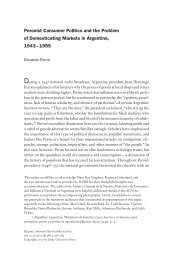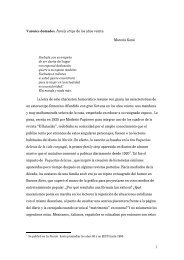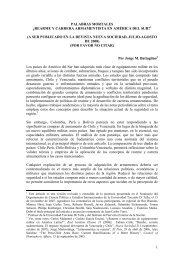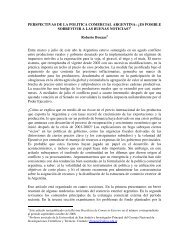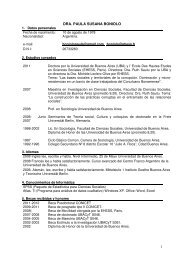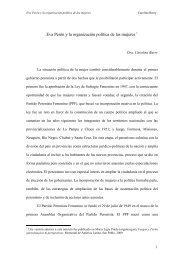Restricted mobility and fixed-mobile convergence in Brazil
Restricted mobility and fixed-mobile convergence in Brazil
Restricted mobility and fixed-mobile convergence in Brazil
Create successful ePaper yourself
Turn your PDF publications into a flip-book with our unique Google optimized e-Paper software.
The article is organized <strong>in</strong> four ma<strong>in</strong> parts. The first provides a brief background on the<br />
evolution of the telecommunications sector <strong>in</strong> <strong>Brazil</strong>, while the second delves <strong>in</strong>to the legal<br />
framework for <strong>fixed</strong> <strong>and</strong> <strong>mobile</strong> telephone services <strong>in</strong> <strong>Brazil</strong>, with particular attention to the<br />
def<strong>in</strong>ition of <strong>fixed</strong> wireless access (FWA) <strong>and</strong> ‘‘restricted <strong>mobility</strong>’’. The third part exam<strong>in</strong>es<br />
how FWA/WLL <strong>and</strong> GSM networks have been deployed by <strong>fixed</strong> phone entrants <strong>in</strong> <strong>Brazil</strong>,<br />
focus<strong>in</strong>g on three cases: Vésper Portátil, Embratel Livre <strong>and</strong> Local or Ruralfone. In the<br />
follow<strong>in</strong>g part, the article addresses the regulatory tensions surround<strong>in</strong>g the def<strong>in</strong>ition of<br />
<strong>fixed</strong> <strong>and</strong> <strong>mobile</strong> services, discuss<strong>in</strong>g recent changes <strong>in</strong> equipment rules <strong>and</strong> regulatory<br />
<strong>in</strong>itiatives seek<strong>in</strong>g to promote entry by small-scale operators <strong>in</strong> low-<strong>in</strong>come <strong>and</strong> low-density<br />
areas.<br />
Prelude to <strong>fixed</strong>-<strong>mobile</strong> <strong>convergence</strong> <strong>in</strong> <strong>Brazil</strong><br />
The telecommunication reforms <strong>in</strong>itiated <strong>in</strong> <strong>Brazil</strong> <strong>in</strong> 1985 has had two def<strong>in</strong><strong>in</strong>g moments:<br />
1. The creation of an <strong>in</strong>dependent regulator (Agência Nacional de Telecomunicações, or<br />
Anatel) <strong>in</strong> 1998.<br />
2. The privatization of the Telebrás System, a state owned hold<strong>in</strong>g which was the largest<br />
Lat<strong>in</strong> American telephone company at that time (Siqueira, 1993; Melo et al., 2005).<br />
Up until 1998, 91 percent of the <strong>Brazil</strong>ian telephone l<strong>in</strong>es belonged to the state owned<br />
Telebrás hold<strong>in</strong>g (Padilha, 2001, p. 26). This scenario shifted drastically after privatization,<br />
as the country was divided <strong>in</strong>to four areas for <strong>in</strong>cumbents of the <strong>fixed</strong> switched telephone<br />
service (STFC) <strong>and</strong> ten areas for <strong>in</strong>cumbents of the emerg<strong>in</strong>g cellular <strong>mobile</strong> service (SMC),<br />
later converted to personal <strong>mobile</strong> service (SMP)[1].<br />
Cellular services played an important role <strong>in</strong> the <strong>Brazil</strong>ian regulatory reforms undertaken <strong>in</strong><br />
the mid 1990s. After seven years of judicial battles, a constitutional amendment was passed<br />
<strong>in</strong> 1995 allow<strong>in</strong>g private enterprises full rights to provide <strong>mobile</strong> telephony services. In<br />
practical terms, <strong>mobile</strong> <strong>and</strong> <strong>fixed</strong> telephone services would be clearly separated <strong>in</strong> 1998,<br />
when the 26 state-owned companies were f<strong>in</strong>ally assembled under three hold<strong>in</strong>gs for <strong>fixed</strong><br />
telephone services <strong>and</strong> eight hold<strong>in</strong>gs for <strong>mobile</strong> telephone services.<br />
S<strong>in</strong>ce then, <strong>Brazil</strong>ian telecommunication regulation has been characterized by an<br />
<strong>in</strong>cremental separation between <strong>fixed</strong> <strong>and</strong> <strong>mobile</strong> telephone services. To beg<strong>in</strong> with, only<br />
<strong>fixed</strong> services are, strictly speak<strong>in</strong>g, subjected to a public service regime. Furthermore,<br />
<strong>mobile</strong> operators are allowed to provide broadb<strong>and</strong> service under the terms of their<br />
current license, while <strong>fixed</strong> operators require an additional license from Anatel as the<br />
service is restricted to data rates of 64 Kbps. In short, favorable tariff <strong>and</strong> service rules,<br />
coupled with lower deployment costs, resulted <strong>in</strong> the rapid expansion of <strong>mobile</strong> services<br />
<strong>in</strong> <strong>Brazil</strong>, while <strong>fixed</strong> services stagnated (Haugen et al., 1994; Männistö <strong>and</strong> Tuisku, 1994;<br />
ITU, 2008).<br />
In 2008, Anatel conducted a technical study (Anatel, 2008) <strong>in</strong> order to establish a<br />
ten-year market outlook <strong>and</strong> propose actions to update the regulatory framework, with<br />
particular attention to accelerat<strong>in</strong>g the diffusion of broadb<strong>and</strong> access services <strong>and</strong><br />
reduc<strong>in</strong>g access barriers <strong>in</strong> high-cost <strong>and</strong> low-<strong>in</strong>come areas. This study became the<br />
basis for the enactment of the general plan of telecommunication regulation update<br />
(PGR). The plan identified <strong>mobile</strong> networks as the most appropriate alternative to<br />
accelerate network deployment, promote the provision of converged services <strong>and</strong><br />
consolidate competition <strong>in</strong> the sector (Anatel, 2008, p. 133). A key concern for Anatel was<br />
to reverse the <strong>in</strong>creas<strong>in</strong>g service gaps between wealthy high-density areas <strong>and</strong><br />
low-density, low-<strong>in</strong>come ones.<br />
Promot<strong>in</strong>g the deployment of FWA was perceived as an alternative to reverse the stagnation<br />
of <strong>fixed</strong> services <strong>and</strong> promote deployment <strong>in</strong> underserved areas (Tr<strong>in</strong>kwon, 1997). The<br />
deployment of FWA/WLL networks started <strong>in</strong> <strong>Brazil</strong> <strong>in</strong> 2001, when Anatel established rules<br />
for the use of the so-called user portable term<strong>in</strong>al equipment (<strong>in</strong> other words, <strong>mobile</strong><br />
h<strong>and</strong>sets) <strong>in</strong> <strong>fixed</strong> phone networks. Currently, <strong>fixed</strong> wireless access (FWA) is def<strong>in</strong>ed <strong>in</strong><br />
<strong>Brazil</strong> as a wireless access application utilized by <strong>fixed</strong> telephony operators for local loop<br />
VOL. 13 NO. 1 2011 j<strong>in</strong>foj PAGE 33



